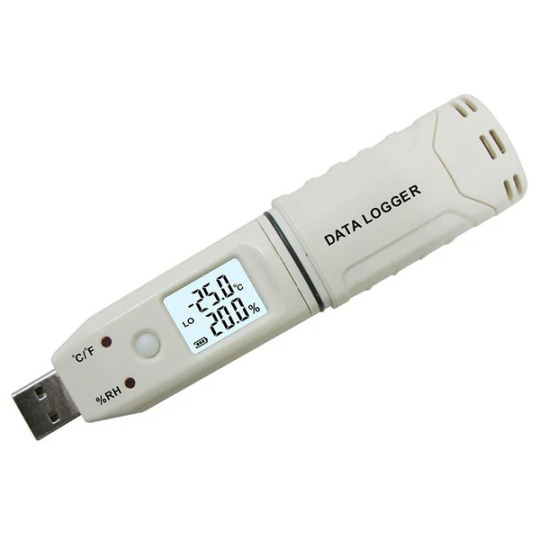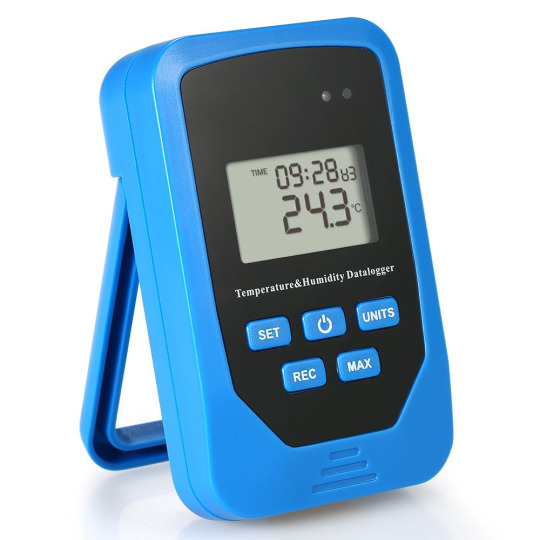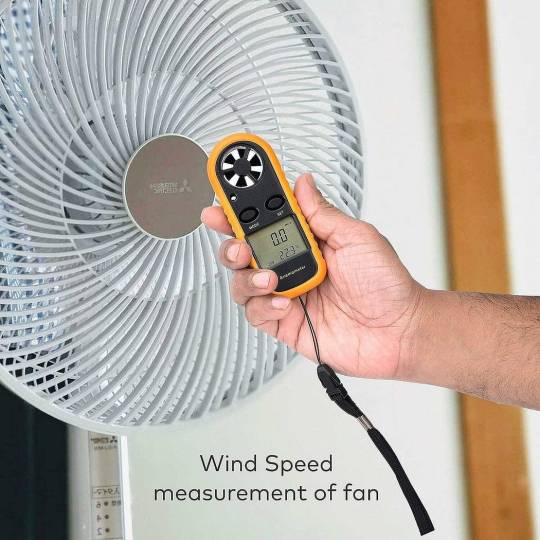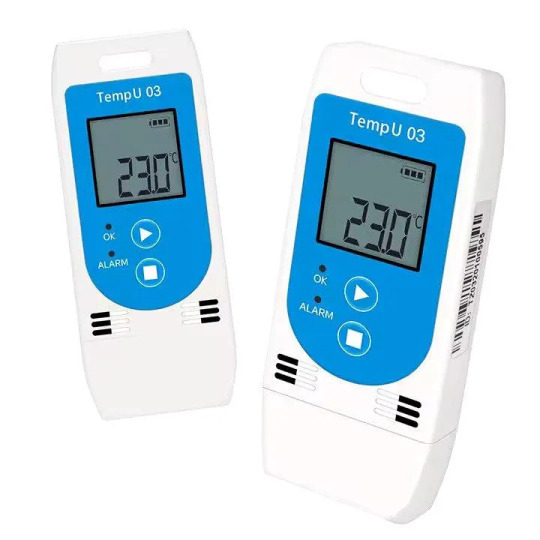#Temperature Data Logger measures
Explore tagged Tumblr posts
Text
Temperature Data Logger Market Insights Technological Advancements Driving Market Growth
The temperature data logger market is witnessing rapid growth due to increased demand for real-time temperature monitoring and enhanced product safety across various industries. These devices play a critical role in ensuring the integrity of temperature-sensitive products, especially in pharmaceuticals, food and beverages, and logistics. As technological advancements continue to shape this sector, the market is evolving to meet the increasing need for precision, efficiency, and regulatory compliance. The global temperature data logger market is expected to expand significantly, driven by advancements in sensor technology, the rise of the Internet of Things (IoT), and the increasing need for traceability in supply chains.

Temperature data loggers are devices that continuously measure and record temperature over time. These devices are used to monitor products in transit or storage, ensuring that they remain within optimal temperature ranges. This technology is vital for maintaining the safety and quality of temperature-sensitive goods, such as pharmaceuticals, vaccines, food, and beverages.
Temperature Data Logger Market Insights: Technological Advancements and Innovations
Technological innovation is a key driver of growth in the temperature data logger market. Recent advancements in sensor technology, connectivity, and cloud computing have enhanced the capabilities of temperature data loggers. Modern loggers feature more accurate sensors, longer battery life, and wireless communication, enabling real-time monitoring and alert systems. These innovations make it easier for industries to ensure compliance with temperature-sensitive product regulations and streamline operations.
Temperature Data Logger Market Insights: The Role of IoT in Temperature Monitoring
The integration of the Internet of Things (IoT) into temperature data loggers is transforming the market. IoT-enabled devices allow for remote temperature monitoring, enabling businesses to access data from anywhere in real time. With cloud-based platforms, companies can track temperature fluctuations, receive alerts, and generate detailed reports, improving operational efficiency and reducing the risk of product spoilage. This shift toward IoT-enabled solutions is expected to drive the market's expansion, particularly in industries requiring constant temperature monitoring, such as pharmaceuticals and food.
Temperature Data Logger Market Insights: Key Industries Driving Growth
Several industries are fueling the demand for temperature data loggers. The pharmaceutical sector is one of the biggest contributors, as it requires strict temperature control for the storage and transportation of drugs, particularly biologics and vaccines. The food and beverage industry also drives growth, as temperature monitoring is crucial to ensure food safety and prevent spoilage. Additionally, the logistics and transportation sectors require temperature data loggers to monitor shipments, especially for perishable goods. The increasing focus on cold chain logistics is expected to further propel the market.
Temperature Data Logger Market Insights: Wireless Solutions Gaining Popularity
Wireless temperature data loggers are becoming increasingly popular due to their ease of use and ability to connect to cloud platforms. Unlike traditional wired systems, wireless loggers do not require physical connections, making them more flexible and scalable. These devices can be deployed across large storage facilities or transportation networks, enabling companies to monitor temperatures remotely and receive instant alerts when temperature thresholds are exceeded. As wireless solutions continue to evolve, they are expected to play a pivotal role in the growth of the market.
Temperature Data Logger Market Insights: Expanding Adoption in Emerging Markets
As industries in emerging economies continue to grow, the adoption of temperature data loggers is expanding. Countries in regions like Asia-Pacific, Latin America, and the Middle East are witnessing increased demand for temperature monitoring solutions, driven by growing pharmaceutical, food, and logistics sectors. Emerging markets are experiencing significant investments in cold chain logistics, healthcare infrastructure, and regulatory compliance, further fueling the adoption of temperature data loggers. This trend is expected to create new opportunities for market players in these regions.
Temperature Data Logger Market Insights: Regulatory Compliance and Industry Standards
Regulatory compliance plays a crucial role in driving the temperature data logger market. In industries like pharmaceuticals and food, stringent regulations require companies to ensure that products are stored and transported under the correct temperature conditions. Non-compliance can lead to product spoilage, safety risks, and legal consequences. As regulations continue to tighten globally, temperature data loggers are becoming essential tools for ensuring compliance and meeting industry standards. This focus on regulatory compliance will continue to influence market growth.
Temperature Data Logger Market Insights: Challenges and Barriers to Adoption
Despite the promising growth of the temperature data logger market, several challenges remain. High initial costs, particularly for advanced temperature monitoring systems, may deter small and medium-sized enterprises (SMEs) from adopting these solutions. Additionally, limited access to reliable internet connectivity in remote areas may hinder the use of IoT-enabled devices in some regions. Companies will need to address these barriers to adoption in order to unlock the full potential of the market.
Temperature Data Logger Market Insights: Advancements in Sensor Accuracy
Improved sensor accuracy is a key trend in the temperature data logger market. Modern temperature data loggers are equipped with high-precision sensors that provide real-time and accurate temperature measurements. This accuracy is particularly important in industries such as pharmaceuticals, where even small temperature fluctuations can compromise product quality. Advancements in sensor technology are expected to drive further innovation in the market, improving the reliability and performance of temperature monitoring systems.
Temperature Data Logger Market Insights: Future Outlook and Market Projections
The future of the temperature data logger market looks promising, with strong growth projected across various industries. As technology continues to improve, the demand for more sophisticated temperature monitoring solutions will rise. The adoption of IoT-enabled devices, wireless solutions, and cloud-based platforms will continue to shape the market, providing businesses with more efficient, cost-effective ways to ensure the safety and quality of their products. With increasing regulatory pressure and the need for enhanced supply chain visibility, the temperature data logger market is poised for continued expansion.
Conclusion
The temperature data logger market is evolving rapidly, driven by technological innovations, increasing demand for real-time temperature monitoring, and the need for regulatory compliance across various industries. As advancements in sensor technology, IoT integration, and wireless solutions continue to reshape the market, businesses in sectors such as pharmaceuticals, food, and logistics are increasingly adopting temperature data loggers to ensure product safety and quality. While challenges such as high costs and limited connectivity persist, the market's growth prospects remain strong, with significant opportunities for innovation and expansion in emerging markets.
#Temperature Data Logger Market#Temperature Data Logger Market trends#Temperature Data Logger#Temperature Data Logger measures#Temperature Data#Temperature
0 notes
Text
Shop Testo: Your Destination for Premium Measuring and Monitoring Solutions
Looking for reliable and innovative measuring equipment? Visit Shop Testo, the ultimate hub for professional measuring devices. Catering to industries such as food safety, pharmaceuticals, HVAC, and more, Shop Testo offers a wide range of tools designed to ensure precision and compliance.
At Shop Testo, you’ll find the equipements that simplify complex tasks. Our selection of temperature monitoring devices includes advanced systems like WiFi-enabled loggers, cloud-based monitoring tools, and high-accuracy thermometers. These devices help to maintain optimal conditions for storage and production, making them essential for businesses that prioritize quality and safety.
For those seeking professional measuring devices, Shop Testo provides a diverse range of instruments tailored to various applications. From humidity meters and air velocity testers to CO2 monitors and data loggers, our devices are designed for precision, durability, and ease of use. Each product meets the highest industry standards, ensuring you have the right tools for your professional needs.

What sets Shop Testo apart is our commitment to customer satisfaction. With detailed product descriptions, user-friendly interfaces, and expert support, we make it easy for you to select the best tools for your operations. Plus, our fast and secure online shopping experience ensures you get the equipment you need, when you need it.
Whether you’re a food safety professional, an HVAC technician, or a laboratory specialist, Shop Testo is the ideal solution for you. Explore our wide range of professional measuring devices to optimize your workflow, enhance accuracy, and maintain compliance with industry regulations.
#Professional measuring devices#Testo measuring instruments#Environmental monitoring devices#Temperature monitoring devices#Humidity monitoring solutions#Food safety measuring tools#Data loggers for industrial use
0 notes
Note
hi!
just saw your pictures of you doing some marine biology fieldwork and i just wondered if you have any stories about the experience that you would like to share. Im in 1st year uni right now and i have no idea what im gonna specialize in other than “science!!” but i work on boats for my job right now (tallships, very cool stuff) and so marine environment work really appeals to me. If you have the time, I would love to get a picture of what the work you’re doing entails.
(What does the day-to day of marine biology research look like? What kind of stuff are you studying/information are you gathering? Whats it like? Is it awesome? feel free to answer none of these also)
thank you!!
OH, I'm jealous - it's a dream of my mine to get to work on a tallship. & I love to talk about this stuff!
In all honesty, the day-to-day changes pretty dramatically depending on what project work is available. Right now, as a student, a lot of what I'm involved in ties into coursework or research that's happening at the university! I volunteer with a couple different labs, and there's a huge variety of stuff to get in on. For example:
Last Saturday, I spent about six hours pulling otoliths and gonads out of eighty invasive roi, taape, and toau caught by local spearfishermen. Otoliths are the ear bones of fish, and similar to the rings of a tree, they have ringed annuli that can give a lot of information about the life history of the individual species. We cast these otoliths in resin, and then cut cross-sections to look at them under the microscope. The hope is that this information will help us understand when these species become reproductive, and how to control their populations.

The last several Fridays, I've been involved with an effort to collect some water quality and plankton data after a lot of heavy rain. This work was out on the boats, and we used deep and shallow drogues, YSI, light meter, secchi disk, and a couple plankton nets, moving out from the swollen rivermouth and into deeper, saltier water.

Last month, I spent a lot of time on invertebrate snorkel surveys, mostly looking for presence/absence in the nearshore. Next Tuesday, I'll be doing fish surveys in the same location. The Wednesday after I'm hopping on a wetlands restoration project & removing invasive bull grass, and a night snorkel afterwards. Next Friday is a lab day, working to process the plankton samples we've collected, and I'll be in the coral nursery afterwards. That's the really fun thing about university - there's so much different work going on, all the time!
In the summers, outside of school, that work is just as varied. I've really enjoyed having jobs that allow me to do a little bit of everything, and thus far, my supervisors have been very supportive of me in that. Here's some other projects I've gotten to work on, all within just one position:


Servicing passive monitoring systems! These are pictures of my replacing a SEABIRD logger, which has been taking a water temperature measurement every thirty seconds for the past 360 days. This helps conservation managers track heatwaves in sensitive ecosystems. We prepped new loggers with batteries and SD cards and waterproof tape to prevent biofouling, and then used snips and zipties to make the switch.

Scientific fishing! This helps get life history and population data for our target species, large pelagic fish. We collected biopsy samples, placed tags, and released primarily ahi, but also ono, and mahi. (Full disclaimer: this picture is from a subsistence fishing trip and not a scientific one, where people generally have too many things in their hands & are moving too quickly to take pictures. He was a very delicious dinner for our crew, though.)


Other marine tagging! I got to assist with bluewater cetacean tagging of several different dolphin and small whale species, and shark tagging for galapagos, blacktip reef, grey reef, and dusky sharks. Cetacean tagging was done with an air rifle, not easy at high speeds on the boat. Shark tagging was more hands-on, as we had to manually apply the tags.


Coral reef monitoring! The mission of these surveys was to track coral health through heat stress events, and to identify harmful species. I'm looking under the coral head in these pictures for crown-of-thorns starfish, one of the most urgent species threats to reefs in the Pacific.

This is the bastard. Notice the dead coral around him.
Oh I'm about to smack into the photo limit, huh. Please hold!
61 notes
·
View notes
Text
Reference archived on our website (click to see this and more than 1,000 other open-access scientific studies! Updates daily!)
Animal study, but in my opinion, it shows the need to rest and recuperate during and after a covid infection.
Abstract Golden Syrian hamsters (Mesocricetus auratus) are a well-established animal model for human infections with severe acute respiratory syndrome coronavirus 2 (SARS-CoV-2) due to their susceptibility to SARS-CoV-2 infection, robust virus replication and pathological manifestations similar to human COVID-19 pneumonia. To investigate the physiological changes upon infection in this animal model, we explored the alterations in daily energy expenditure (DEE), water turnover, body mass, body temperature, and locomotor activity in non-infected and SARS-CoV-2 infected Golden Syrian hamsters for four days post SARS-CoV-2. DEE was measured using the doubly labelled water method, which allows for the accurate estimation of carbon dioxide production and, consequently, energy expenditure in animals. Additionally, we investigated total water intake (TWI), which comprises drinking water, preformed water in food, and metabolic water. Using intraperitoneally implanted data loggers, we also monitored body core temperature and locomotor activity in some of the animals. Here we provide evidence for infected hamsters exhibiting significantly lower DEE and TWI compared to non-infected animals. We also observed an increase in body weight in the non-infected animals, while infected animals experienced weight loss. Further, infected animals showed a significantly decreased body temperature, indicating a generally lowered metabolic rate.
#mask up#covid#pandemic#covid 19#wear a mask#public health#coronavirus#sars cov 2#still coviding#wear a respirator
7 notes
·
View notes
Text

Thermal refugia and persistence of Texas horned lizards (Phrynosoma cornutum) in small towns
Mary R. Tucker, Daniella Biffi, Dean A. Williams
Vegetation loss is a primary cause of habitat degradation and results in a decline in reptile species abundance due to loss of refuge from predators and hot temperatures, and foraging opportunities. Texas horned lizards (Phrynosoma cornutum) have disappeared from many areas in Texas, especially from urbanized areas, probably in large part due to loss of suitable habitat. This species still occurs in some small towns in Texas that still contain suitable habitat. Long-term data from Kenedy and Karnes City, Texas indicate that when study sites experienced significant shrub and vegetation removal horned lizards declined by 79%. We hypothesize the decline was due to the degradation of the thermal landscape for these lizards. We determined the preferred temperature range (Tset25 – Tset75) of lizards at our study sites and took field measurements of body temperature (Tb). Temperature loggers were also placed in three microhabitats across our study sites. Shrubs and vegetation provided the highest quality thermal environment, especially for about 5 h midday when temperatures in the open and buried under the surface in the open exceeded the lizards' critical maximum temperature (CTmax) or were above their preferred temperature range. Horned lizard density was positively related to the thermal quality of the habitat across our sites. Texas horned lizards in these towns require a heterogeneous mix of closely spaced microhabitats and especially thermal refugia, such as shrubs and vegetation along fence lines and in open fields. Maintaining thermal refugia is one of the most important and practical conservation actions that can be taken to help small ectotherms persist in modified human landscapes and cope with increasing temperatures due to climate change.
Read the paper here:
Thermal refugia and persistence of Texas horned lizards (Phrynosoma cornutum) in small towns - Tucker - 2023 - Ecology and Evolution - Wiley Online Library
30 notes
·
View notes
Photo

A Dockside Mini Observatory Keeps Watch Over a Troubled Lake
Dear Eos:
Time-series observatories serve the vital role of monitoring ongoing ecosystem changes around the clock. Over the past 12 years (2011-2022), the Muskegon Lake Observatory buoy (MLO) has closely tracked the dynamics of thermal stratification, eutrophication, harmful algal blooms and bottom water hypoxia in Muskegon Lake – a troubled Great Lakes estuary and Area of Concern. However, lack of funding in recent years for long-term projects such as MLO has forced us to innovate to gather essential environmental data on this urbanized Great Lakes estuary that is still undergoing restoration.
We recently assembled and deployed a low-cost land-based mini observatory using reconfigured equipment from the main MLO (Mini-MLO) that monitors the changing surface water quality in Muskegon Lake every hour. Here, undergraduate student Kyle, is using a harness to hang out on the pier’s climbing ladder over the lake to change the batteries in the data logger powering the submerged sonde. The sonde has sensors that measure changes in water quality parameters such as temperature, dissolved oxygen, pH and chlorophyll that the data logger transmits to the project website www.gvsu.edu/buoy/. If we are to comprehend ongoing short-term changes due to weather and anthropogenic disturbances, and long-term changes due to climate change and ENSO, this observing science show must go on…
– Kyle McKee, Nate Dugener, Kaylynne Dennis, Connor Gabel, Tony Weinke and Bopi Biddanda, Annis Water Resources Institute, Grand Valley State University, Muskegon, Michigan, USA www.gvsu.edu/wri/.
3 notes
·
View notes
Text
Quality First: How Invimeds Ensures Top-notch Quality in Generic Medicines Supply
In the current pharmaceutical landscape, there is a growing demand for generic medicines driven by factors such as affordability and accessibility. Invimeds, as a top generic medicine distributor in this sector, prioritizes the delivery of high-quality products to healthcare providers and patients globally. Quality assurance is central to our operations, from sourcing to distribution, ensuring the safety and efficacy of every medication we supply.
Sourcing From Trusted Partner
Our dedication to quality is the meticulous selection of suppliers. We exclusively partner with esteemed manufacturers and suppliers who uphold Good Manufacturing Practices (GMP) and rigorous quality control standards. Through collaborations with WHO GDP-certified manufacturers and suppliers, Invimeds guarantees that each product meets the most stringent global quality criteria.
Stringent Quality Control Measures:
Quality assurance is paramount at every stage of Invimeds' supply chain. Upon receiving products, thorough quality checks are conducted to verify authenticity, potency, and purity. We strictly adhere to regulatory standards set by global health authorities like the FDA and EMA, ensuring all products meet the highest safety and efficacy benchmarks.
This includes maintaining optimal storage and transportation conditions to preserve product integrity throughout the supply chain. Our specialized support team is dedicated to providing tailored solutions for patients and healthcare professionals, backed by our commitment to compliance, stringent quality control, and ethical practices.
Transparent Documents:
As a distributor of generic drugs, we prioritize your health and offer transparent services. We provide comprehensive documentation, including COA, Batch Report, COO, COPP, and more, for your review, fostering trust and confidence in our products and processes.
At Invimeds Health, we offer a new standard in pharmaceutical distribution, prioritizing efficient storage and secure handling of essential drugs. Our facilities feature advanced temperature and security controls, ensuring medication integrity in ambient, refrigerated, and sub-zero environments. From inventory management to distribution, we leverage advanced data loggers for precise supply chain management.
#pharmaceutical distributors#generic medicines#generic medicine distributor#supply of generic medicine
2 notes
·
View notes
Text
Rotary Torque Sensors: Enhancing Rotational Force Measurement with Star EMBSYS Solutions
Rotary torque sensors are critical components used to measure the rotational force (torque) applied on a rotating system, such as motors, gearboxes, or turbines. These sensors are essential in performance testing, quality control, and process monitoring across industries like automotive, aerospace, robotics, and manufacturing. Among the innovative providers in this space, Star EMBSYS offers high-performance, customizable rotary torque sensor systems that integrate advanced embedded technology for unmatched precision and reliability.
A rotary torque sensor measures torque by detecting the strain (twisting) on a rotating shaft. Typically based on strain gauge or magnetoelastic principles, these sensors output a signal proportional to the applied torque. Unlike static torque sensors, rotary torque sensors are designed to operate on rotating shafts, often using slip rings, wireless telemetry, or rotary transformers to transmit data.
Star EMBSYS brings its embedded systems expertise into torque sensing by offering intelligent rotary torque sensor solutions. These systems are equipped with real-time data acquisition, signal conditioning, and digital communication interfaces, making them ideal for dynamic and high-speed applications. Their sensors support both analog (voltage/current) and digital (UART, SPI, I2C, CAN) outputs, ensuring seamless integration with control systems, data loggers, and monitoring software.
One of the core strengths of Star EMBSYS is its ability to deliver customized sensor solutions tailored to the client’s mechanical and electrical requirements. Whether it's a high-precision lab-grade application or a rugged industrial setting, Star EMBSYS designs torque sensors with features like temperature compensation, vibration resistance, and long-term stability. Their embedded firmware ensures accurate real-time monitoring with minimal latency, critical for applications like EV motor testing or robotic joint torque feedback.
Additionally, Star EMBSYS offers user-friendly calibration and diagnostic tools, allowing engineers to maintain accuracy and system health over time. Their rotary torque sensors can be combined with wireless telemetry for remote monitoring, a vital feature for testing in mobile or rotating systems where cabling is impractical.
In conclusion, rotary torque sensors are essential for understanding and optimizing mechanical performance. Star EMBSYS stands out by delivering not just sensors, but smart embedded torque measurement solutions that empower engineers with real-time, high-fidelity data. With a commitment to innovation and customization, Star EMBSYS is a trusted partner for precision torque sensing in today’s demanding engineering applications.
Visit:- https://www.starembsys.com/rotary-torque-sensor.html
0 notes
Text
What to Look for in Industrial Measurement Equipment for Manufacturing Facilities
In manufacturing, precision is everything. Whether you're producing electronics, automotive components, pharmaceuticals, or food packaging, accuracy in measurement directly impacts quality, safety, and regulatory compliance. That’s why investing in the right industrial measurement equipment is not only a smart decision—it’s a critical one.
But with so many options on the market, how do you choose the right tools for your facility?
At EpicRise Electronics, we help businesses across industries source high-performance tools and IT equipment, including measurement systems, scanners, and wholesale label printers. Here's what to look for when equipping your manufacturing facility with industrial measurement solutions.
1. Accuracy and Reliability
The foremost priority in any measurement equipment is accuracy. Whether you're measuring weight, temperature, humidity, voltage, or dimensional properties, even the smallest margin of error can lead to production defects, wasted materials, and safety issues.
Look for devices that meet or exceed ISO or NIST standards and are tested for industrial-grade precision. It’s also essential that the equipment performs consistently over time without needing frequent recalibration.
Tip: Opt for trusted manufacturers that offer certification or documentation on equipment accuracy. Brands partnered with EpicRise often come with reliability reports and compliance details.
2. Durability and Build Quality
Manufacturing environments are often harsh—subject to heat, moisture, dust, vibration, and continuous operation. Your measurement tools must be built for endurance.
When sourcing items such as laser measurement devices, multimeters, or pressure gauges, choose models specifically designed for industrial environments. Features to consider include:
Rugged casings (shock-proof, waterproof, dustproof)
High-quality connectors and cables
Resistance to chemicals or oil
Durability reduces downtime and repair costs—especially in 24/7 operations.
3. Integration with Existing Systems
Modern manufacturing facilities are increasingly automated and data-driven. Measurement devices should seamlessly integrate with your existing systems, whether that’s SCADA software, ERP platforms, or IoT networks.
Look for equipment with USB, Ethernet, or Bluetooth connectivity, and ensure it's compatible with your current software architecture. This allows real-time data collection and monitoring, improving decision-making and traceability.
Pro Tip: Integration also extends to your labeling and tracking tools. For instance, pairing a Zebra barcode scanner with automated weighing or inspection stations ensures that product IDs and measurement data flow smoothly across systems.
4. Ease of Use and Operator Training
Complex equipment that requires excessive training can slow down operations and increase the likelihood of user error. Choose tools that offer intuitive interfaces, clear displays, and simple calibration procedures.
Many leading brands also offer training resources, online support, and documentation. These are crucial when onboarding new team members or troubleshooting issues on the production floor.
At EpicRise, we prioritize stocking measurement tools with user-friendly design, backed by strong manufacturer support and documentation.
5. Scalability and Upgrade Potential
Your facility’s needs today might not be the same five years from now. The best industrial measurement systems are modular or scalable—allowing you to expand or upgrade without overhauling your entire process.
For example:
Multichannel data loggers can be expanded with additional sensors.
Barcode readers and scanners can be upgraded with advanced software.
Integrated systems can support added devices as your production grows.
When planning for growth, choose flexible solutions that evolve with your operations.
6. Data Logging and Traceability Features
In highly regulated industries—like food, medical devices, or aerospace manufacturing—data traceability is non-negotiable. Measurement tools should offer internal storage, cloud connectivity, or the ability to export logs securely.
This helps meet compliance standards (e.g., FDA, ISO 9001) and supports quality audits, troubleshooting, and continuous improvement initiatives.
Pairing your measurement devices with wholesale label printers also boosts traceability. With every reading, you can instantly generate barcode labels that reflect batch numbers, inspection dates, or critical data points.
7. Brand Reputation and Support
With industrial-grade tools, it pays to choose reputable brands with proven track records. These manufacturers typically offer:
Better warranties
Firmware updates
Technical support
Long-term availability of spare parts
One such example is Zebra Technologies, a leader in tracking and scanning tools. Their Zebra barcode scanner models are known for reliability in industrial environments, offering high-speed scanning, rugged durability, and seamless integration with other factory systems.
EpicRise is proud to offer Zebra products, along with measurement devices and peripherals from top global brands.
8. Cost Efficiency Through Wholesale Channels
Quality measurement equipment can be a major investment, especially if you’re outfitting an entire facility. Buying through a distributor like EpicRise Electronics means you gain access to wholesale pricing, faster shipping, and expert consultation.
Need to bundle tools with scanning devices, power supplies, or network equipment? We make procurement simple and affordable by offering:
Wholesale label printers
Bulk orders of barcode scanners and sensors
Compatible accessories and software
You don’t have to compromise quality for budget—EpicRise delivers both.
Final Thoughts
Investing in the right industrial measurement equipment pays dividends across your manufacturing operation—from better product quality and compliance to increased efficiency and cost savings. But success starts with sourcing smart.
When you work with EpicRise Electronics, you get more than just tools—you get a trusted partner in procurement. From Zebra barcode scanner systems to durable measurement devices and wholesale label printers, we supply the equipment that powers precision manufacturing.Need help choosing the right gear for your facility? Explore our full product range at EpicRiseElectronics.com or contact our support team for a custom quote today.
0 notes
Text
Temperature Data Logger Market Growth Drivers Transforming Global Industry Dynamics Rapidly
The Temperature Data Logger Market is witnessing significant growth driven by several critical factors shaping its expansion globally. Temperature data loggers are essential devices that record temperature over time, ensuring safety, quality, and compliance in various sectors such as pharmaceuticals, food and beverage, healthcare, and logistics. Understanding the key drivers propelling this market helps businesses and investors capitalize on emerging opportunities and address evolving industry needs.

One of the primary drivers of the Temperature Data Logger Market is the increasing demand for reliable temperature monitoring solutions in the pharmaceutical and healthcare industries. Maintaining strict temperature control during the storage and transportation of vaccines, medicines, and biological samples is critical to preserve their efficacy and safety. With the surge in vaccine distribution globally, especially highlighted by the COVID-19 pandemic, the need for temperature data loggers has intensified. These devices help ensure that sensitive products remain within required temperature ranges throughout the supply chain, reducing spoilage risks and compliance violations.
Technological advancements are another vital driver fueling the market’s growth. Modern temperature data loggers are equipped with wireless connectivity, real-time monitoring, and cloud-based data management features, allowing users to track temperature variations remotely and receive instant alerts in case of anomalies. The integration of Internet of Things (IoT) technology has enhanced the efficiency and accuracy of these devices, making them more user-friendly and adaptable across diverse applications. Innovations such as compact designs, longer battery life, and multi-parameter sensing capabilities have broadened their usability, thereby increasing market penetration.
Strict government regulations and industry standards related to temperature control and monitoring have also accelerated the adoption of temperature data loggers. Regulatory bodies worldwide mandate precise temperature tracking in sectors like food processing, pharmaceuticals, and cold chain logistics to ensure consumer safety and product quality. Compliance with regulations such as the FDA’s Good Manufacturing Practices (GMP), WHO guidelines, and HACCP (Hazard Analysis and Critical Control Points) is driving businesses to invest in advanced temperature monitoring systems. These regulatory requirements create a steady demand for temperature data loggers, especially in regions with stringent quality control standards.
The growth of cold chain logistics is another significant market driver. With the rise in global trade of perishable goods, including fresh food, seafood, and temperature-sensitive pharmaceuticals, efficient cold chain management has become paramount. Temperature data loggers play a crucial role in monitoring environmental conditions during transportation and storage, reducing the risk of product degradation. Increasing consumer awareness about food safety and quality further supports the expansion of cold chain infrastructure, indirectly boosting the demand for temperature data logging solutions.
Furthermore, expanding end-use industries contribute to market growth. Apart from healthcare and food, sectors such as agriculture, chemical manufacturing, and environmental monitoring require precise temperature measurement to optimize operations and maintain product integrity. For example, in agriculture, monitoring soil and storage temperatures helps improve crop yields and reduce wastage. Similarly, in chemical industries, maintaining controlled temperature conditions is essential for safe processing and storage of volatile substances. The broadening application scope enhances the overall demand for temperature data loggers.
Cost-effectiveness and ease of use also act as drivers for widespread adoption. Many temperature data loggers are now designed to be plug-and-play devices that require minimal technical expertise, encouraging small and medium-sized enterprises to implement temperature monitoring solutions. Additionally, the availability of affordable models without compromising accuracy has made these devices accessible to a larger customer base. This democratization of temperature monitoring technology is expected to contribute substantially to market growth in emerging economies.
The rising trend of digitalization and Industry 4.0 initiatives across manufacturing and supply chain operations further supports the Temperature Data Logger Market. Organizations aiming to enhance transparency, traceability, and operational efficiency adopt advanced temperature monitoring tools integrated with data analytics platforms. The insights generated from temperature data help businesses make informed decisions, reduce wastage, and comply with safety standards. The synergy between digital transformation and temperature data logging presents a promising growth avenue.
Lastly, increasing awareness of sustainability and reduction of food and drug wastage is encouraging industries to implement efficient temperature control measures. Temperature data loggers provide actionable insights that help reduce losses caused by improper storage conditions, supporting eco-friendly practices and cost savings. As environmental concerns become a priority globally, this driver will play a more significant role in shaping market dynamics.
In summary, the Temperature Data Logger Market growth is propelled by multiple intertwined drivers: escalating demand for temperature-controlled logistics, technological innovations, regulatory compliance, expansion of end-use industries, and the digital transformation of supply chains. These factors collectively create a robust ecosystem supporting market expansion. Companies investing in research, product development, and strategic partnerships are well-positioned to leverage these growth drivers and capture emerging opportunities in this evolving market landscape.
0 notes
Text
Smart Features in Temperature Data Loggers Enhancing Market Potential
The temperature data logger market is experiencing substantial growth as industries seek precise and efficient solutions for monitoring temperature-sensitive products. These devices are essential for ensuring product quality, safety, and compliance with industry regulations. With advancements in technology, temperature data loggers now offer real-time data collection, wireless communication, and integration with IoT platforms.

Advancements in Temperature Data Logger Technology
One of the key drivers of the temperature data logger market is the integration of advanced technologies such as IoT (Internet of Things). This enables real-time monitoring and seamless data transfer across multiple devices and platforms. Smart temperature data loggers offer features like remote access, automated alerts, and predictive analytics, making them indispensable for industries such as pharmaceuticals, food & beverages, and logistics.
Key Drivers Influencing the Temperature Data Logger Market
Increased Regulatory Compliance As industries face stricter regulations regarding the storage and transportation of temperature-sensitive products, the demand for accurate data loggers has risen. These devices ensure compliance with industry standards, particularly in pharmaceuticals and food safety.
Growth of Wireless and IoT-enabled Solutions Wireless temperature data loggers are becoming increasingly popular due to their ease of use and ability to provide real-time data without physical connections. The adoption of IoT technologies allows seamless data integration with other smart systems, improving operational efficiency.
Sustainability and Energy Efficiency Companies are focusing on sustainable solutions, driving the development of energy-efficient temperature data loggers. These devices reduce power consumption while maintaining high precision, catering to eco-conscious industries.
Cost-Efficiency and Accessibility With advancements in technology, temperature data loggers have become more cost-effective and accessible to businesses of all sizes. Small and medium enterprises (SMEs) are increasingly adopting these devices to ensure quality control without heavy investments.
Smart Features Enhancing Data Security Security remains a top priority for temperature data loggers, especially with sensitive data being stored and transmitted. Advanced security features such as encryption and secure wireless communication protocols are being integrated to protect against cyber threats.
Market Challenges and Opportunities
While the market for temperature data loggers is expanding rapidly, challenges such as data privacy concerns and varying regional regulations persist. However, opportunities lie in the development of more specialized solutions for industries like biotechnology, where high precision and reliability are critical.
Conclusion
The temperature data logger market is evolving at a rapid pace, driven by advancements in technology and increasing demand for accurate monitoring of temperature-sensitive products. From wireless IoT solutions to energy-efficient devices, these innovations are reshaping how industries manage their temperature data, ensuring product integrity and safety across various sectors.
#Temperature Data Logger Market#Temperature Data Logger Market trends#Temperature Data Logger#Temperature Data Logger measurements#Temperature Data giver#Data Logger Market
0 notes
Text
Testo GCC: Your Hub for Professional Measuring Devices in UAE
Discover Testo GCC, your go-to destination for professional measuring devices and test and measurement equipment in the UAE. Whether you're in HVAC, refrigeration, or food safety, Testo offers top-tier tools designed to provide precise and reliable results. From cutting-edge instruments to calibration services and expert repairs, Testo GCC ensures that professionals across various industries receive the best quality solutions. With a wide range of products available, Testo meets your specific testing needs, ensuring accuracy in every job!

1 note
·
View note
Text
How DAQ Systems and Monitoring Equipment Drive Quality ?
In industries where temperature-sensitive goods play a critical role—such as pharmaceuticals, food and beverage, and biotechnology—maintaining the right environmental conditions during storage and transportation is not just important, it's essential. The complexity of ensuring product safety and regulatory compliance has driven rapid advancements in remote cold chain monitoring systems, offering businesses the ability to oversee their entire supply chain in real-time.
What Are Remote Cold Chain Monitoring Systems?
Remote cold chain monitoring systems are integrated solutions that use wireless sensors, cloud platforms, and real-time data analytics to monitor temperature, humidity, and other environmental parameters throughout the supply chain. These systems are designed to continuously track conditions and alert stakeholders when there's any deviation from the preset thresholds. This capability is particularly important in global logistics, where goods may pass through various climate zones and handling processes.
Unlike traditional cold chain systems that rely on manual checks or delayed data retrieval, remote cold chain monitoring systems provide live updates and automated reports. This level of transparency helps businesses react instantly to temperature fluctuations, reducing the risk of spoilage, waste, and costly recalls.
The Importance of Cold Chain Monitoring Equipment
For these systems to function accurately and efficiently, they rely on high-quality cold chain monitoring equipment. This includes a range of devices such as temperature data loggers, digital sensors, thermal mapping tools, and GPS-enabled tracking units. These tools are often embedded within packaging or installed inside storage units and transport vehicles.
Modern cold chain monitoring equipment is designed to be compact, durable, and energy-efficient. Some devices come with advanced features like automated calibration, cloud synchronization, and tamper-proof logs. These improvements not only enhance data accuracy but also simplify compliance with regulations set by agencies such as the FDA, WHO, and EMA.
Having reliable cold chain monitoring equipment in place allows logistics providers, manufacturers, and retailers to maintain product quality across every stage of the journey—from manufacturing facilities to end-users.
The Role of DAQ Systems in Cold Chain Monitoring
At the heart of every efficient cold chain monitoring setup is a robust data infrastructure. This is where DAQ systems (Data Acquisition Systems) come in. These systems collect, process, and analyze data from multiple sensors, helping stakeholders gain a comprehensive view of environmental conditions.
DAQ systems are responsible for turning raw sensor inputs into meaningful insights. They measure variables such as temperature, humidity, air pressure, and vibration, storing the information in centralized dashboards. This allows decision-makers to track trends over time, identify areas of risk, and make proactive adjustments to avoid potential failures.
Advanced DAQ systems are also capable of integrating with enterprise resource planning (ERP) systems, enabling seamless data flow across different business functions. This integration is key for businesses looking to optimize inventory, forecast demand, and maintain end-to-end visibility across their supply chains.
Benefits of Integrated Monitoring Solutions
The combination of remote cold chain monitoring systems, sophisticated cold chain monitoring equipment, and powerful DAQ systems provides several benefits:
Real-time visibility: Stakeholders can monitor product conditions at any time, from anywhere.
Risk reduction: Automated alerts help prevent costly product losses.
Regulatory compliance: Digital records ensure readiness for audits and inspections.
Operational efficiency: Data-driven insights lead to better resource management and reduced downtime.
Customer trust: Ensuring product integrity builds brand reputation and customer confidence.
The Future of Cold Chain Monitoring
Looking ahead, the cold chain industry is poised for further innovation. The integration of artificial intelligence (AI), blockchain, and Internet of Things (IoT) technologies will make remote cold chain monitoring systems even smarter and more secure. Predictive analytics will allow companies to anticipate problems before they arise, and digital twins will enable virtual simulations of supply chain conditions.Investing in high-quality cold chain monitoring equipment and scalable DAQ systems is no longer optional—it's a strategic move for businesses aiming to stay competitive in a data-driven, quality-focused market.
0 notes
Text
Why an HVAC System Audit is Crucial for Energy Efficiency and Cost Savings

Introduction
If you’re looking to reduce energy bills, enhance indoor comfort, and extend the lifespan of your heating and cooling systems, an HVAC system audit is an essential first step. This comprehensive inspection identifies inefficiencies, maintenance issues, and opportunities to optimize your HVAC system performance. Whether you're a homeowner or a facility manager, understanding how your HVAC system operates—and where it’s losing energy—can make a significant impact on your bottom line.
What is an HVAC System Audit?
An HVAC system audit is a detailed assessment of your heating, ventilation, and air conditioning systems. Conducted by certified HVAC professionals, the audit evaluates how well your system is performing and pinpoints issues such as:
Poor airflow
Inadequate insulation
Leaks in ductwork
Dirty filters or coils
Outdated or inefficient components
Using tools like infrared thermography, air balancing equipment, and data loggers, auditors collect vital performance data and suggest corrective measures.
Key Benefits of an HVAC Audit
Improved Energy Efficiency One of the biggest benefits of an HVAC audit is uncovering energy waste. Even minor issues like clogged filters or leaking ducts can cause your system to work harder, using more energy than necessary. An audit identifies these problems and helps reduce your utility bills.
Lower Operating Costs By fixing inefficiencies, your system operates more smoothly, reducing wear and tear. This leads to fewer breakdowns and costly emergency repairs.
Enhanced Indoor Air Quality An audit also assesses ventilation effectiveness, filter status, and moisture levels—key components in maintaining healthy indoor air quality. Cleaner air improves occupant health and comfort.
Extended Equipment Lifespan Regular audits help you spot and fix small problems before they escalate. This proactive maintenance approach extends the life of your HVAC system and delays costly replacements.
Regulatory Compliance For commercial buildings, HVAC audits can ensure compliance with local energy codes, standards, and sustainability goals. In some regions, audits are even required for energy certification.
What to Expect During an HVAC Audit
A typical audit includes:
Visual Inspection: Checking the condition of units, ducts, and vents.
System Testing: Measuring airflow, pressure, and temperature outputs.
Energy Analysis: Reviewing utility bills and system usage patterns.
Recommendations: A detailed report highlighting inefficiencies, proposed upgrades, and a cost-benefit analysis.
Depending on the findings, recommendations may include duct sealing, thermostat upgrades, insulation improvements, or full equipment replacements.
When Should You Schedule an HVAC Audit?
You should consider an HVAC audit if:
Your energy bills have unexpectedly increased.
Rooms in your home or building are unevenly heated or cooled.
Your system is more than 10 years old.
You’re planning renovations or system upgrades.
Indoor air quality has noticeably declined.
Annual audits are a good practice for both residential and commercial systems, especially before peak heating or cooling seasons.
Conclusion
Investing in a professional HVAC system audit can lead to significant energy savings, improved comfort, and long-term cost reductions. Whether you’re focused on sustainability, system performance, or lowering operational costs, a comprehensive HVAC audit provides the insights you need to make informed decisions. Don’t wait for breakdowns—take a proactive approach to HVAC efficiency today.
HVAC MasterLabs Barsha Heights, Dubai, UAE 971-501001615 [email protected] https://hvacml.ae/
0 notes
Text
Precision in Practice: Why Data Loggers and Anemometers Are Essential for Industry and Innovation
In an era where smart systems, sustainability, and safety define success, the demand for accurate data has never been higher. Whether it’s a construction engineer measuring wind pressure or a scientist monitoring climate change, reliable tools are required to capture and record real-world conditions with precision.

Among the most crucial instruments in this field are the Data Logger and the Anemometer. Often overlooked due to their compact size, these tools play a major role across sectors, enhancing productivity, ensuring safety, and supporting research. Let’s dive deeper into their importance, functionality, and real-world applications.

What is a Data Logger?
A Data Logger is an electronic device that records measurements over time at set intervals. It can include internal sensors, external probes, or both, depending on the application.
Common Parameters Measured:
Temperature and Humidity
Voltage and Current
Pressure and Air Quality
Light Intensity
Sound and Vibration Levels
The primary purpose of a Data Logger is to automate the process of data collection, making it more reliable, scalable, and accurate than manual methods. Most models are battery-powered and built to operate unattended in remote or sensitive environments.
Applications of Data Loggers:
Pharmaceutical Supply Chains: Monitoring temperature and humidity in vaccine transportation.
Agriculture: measuring the soil temperature and moisture to optimize irrigation.
Energy Audits: Logging power consumption in buildings and factories.
Environmental Research: Collecting long-term data for climate models.
At uniglobalbusiness, you’ll find a wide range of Data Loggers with USB, wireless, and cloud-enabled connectivity, allowing users to easily export and analyze data. Their compact form factor and rugged design make them ideal for both indoor labs and challenging outdoor environments.
What is an Anemometer?
An Anemometer is a device that is used to measure wind speed, and in some models, wind direction. It is an essential tool in meteorology, aviation, construction, and renewable energy sectors.
Types of Anemometers:
Cup Anemometers: They use rotating cups to measure wind speed.
Vane Anemometers: It combines a wind vane and a propeller for direction and speed.
Ultrasonic Anemometers: Use sound waves to detect wind flow — ideal for high-accuracy applications.
Where Are Anemometers Used?
Wind Farms: Determine optimal locations for wind turbines.
Weather Stations: Provide data for forecasting and climate modeling.
Construction Sites: Ensuring crane and equipment safety in high-wind conditions.
Agriculture: Help with time pesticide spraying and irrigation based on wind speed.
uniglobalbusiness offers a reliable selection of portable and fixed Anemometers, suitable for both professional and academic use. Each model is chosen for durability, precision, and ease of calibration — essential traits for environments where wind data is mission-critical.
How Uniglobalbusiness Helps You Measure with Confidence
When it comes to instrumentation, reliability and service matter as much as specifications. That’s why industry professionals and researchers trust Uniglobalbusiness for their measurement needs.
Here’s what sets them apart:
Curated collections that balance affordability with performance
Products tested for industrial and academic standards
Ongoing support and transparent product information
By choosing tools from Uniglobalbusiness, you’re not just purchasing devices — you’re investing in a smoother workflow, better data accuracy, and long-term efficiency.
Final Thoughts: Why These Tools Matter Now More Than Ever
The shift toward smart, sustainable systems requires accurate environmental and operational data. Instruments like the Data Logger and Anemometer enable this shift by providing the real-time insights necessary to optimize performance, ensure safety, and support compliance.

CONTACT US
Uniglobal Business
Plot number 3 Office No : A22 ( 6th Floor) Wegmans Signature Tower Knowledge Park 3 Above Decathlon Greater Noida 201310
Email Us : [email protected]
Enquiry : +91–9278333555, 9312349595
Website:- https://uniglobalbusiness.com/
0 notes
Text
What Are Automated Weather Stations?
Automated Weather Stations (AWS) are modern, self-contained systems designed to monitor and record weather conditions without the need for constant human oversight. They are equipped with a range of sensors and instruments that collect real-time data on various environmental factors such as temperature, humidity, wind speed and direction, rainfall, solar radiation, and atmospheric pressure.
How Do They Work?
At the core of an AWS is a set of sensors connected to a data logger—a device that stores the measurements. These stations are often powered by solar panels and include a battery backup to ensure they can operate in remote or off-grid locations.
The data collected is automatically transmitted to a central server or cloud-based platform via cellular, Wi-Fi, or satellite communication. This allows users to access the weather information from anywhere, often through a web dashboard or mobile app.
Key Features of Automated Weather Stations:
Real-Time Monitoring: Provides up-to-the-minute weather data.
Remote Access: View data online from your phone, tablet, or computer.
Low Maintenance: Once set up, they require minimal intervention.
Customizable Sensors: Many models allow users to add or remove sensors depending on their specific needs.
Data Logging & Alerts: Stores historical data and can trigger alerts for specific conditions like high winds or heavy rainfall.
Who Uses Automated Weather Stations?
AWS units are used across many fields:
Agriculture: Farmers rely on them for irrigation planning, frost warnings, and crop management.
Construction & Engineering: Sites use AWS to monitor weather for safety and project planning.
Research: Scientists and meteorologists collect climate data over long periods.
Education: Schools and universities use them for hands-on learning in environmental science.
Homeowners & Enthusiasts: Personal stations are great for tracking local weather in real-time.
Why Are They Important?
Automated Weather Stations offer accurate, continuous, and location-specific weather data, which is essential for decision-making in many industries. Whether you're a farmer looking to optimize crop yields or a weather enthusiast tracking your local microclimate, AWS provide valuable insights with minimal effort.
#weathertech#weatherstation#automatedweatherstation#smartgarden#farmingtech#meteorology#homesteading#backyardweather#scienceisawesome#climatewatch#diyweather#weathernerd#sensors#techlovers#greenliving#sustainabletech#tumblrscience
0 notes